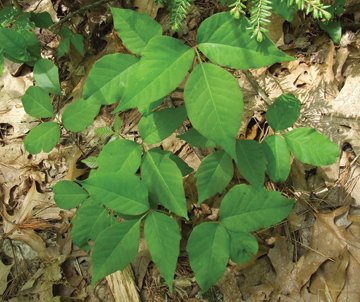Whatever troubles climate change might bring to the world’s other species, rising carbon dioxide in the atmosphere could be the best thing yet for poison ivy.

An outdoor experiment mimicking the carbon dioxide rise predicted for this century found that poison ivy vines grew more than twice as much per year as they did in unaltered air, says Jacqueline E. Mohan, now of the Marine Biological Laboratory in Woods Hole, Mass. That growth streak is nearly five times the increase reported for some tree species in other analyses.
More bad news: The jolt of carbon dioxide also boosted the most-toxic forms of poison ivy’s rash-raising oil, Mohan and her colleagues report in the June 13 Proceedings of the National Academy of Sciences.
“It’s a sobering example that rising carbon dioxide can favor pests and weeds, those plants we’d least like to see succeed,” comments climate-change ecologist Bruce Hungate of Northern Arizona University in Flagstaff.
People burning fossil fuels release carbon dioxide into the atmosphere. As the atmosphere gains carbon dioxide and other so-called greenhouse gases, it traps more of the sun’s heat.
Biologists have wondered whether this carbon boost might work as aerial fertilizer for plants. Earlier lab experiments found plants growing exuberantly with extra carbon dioxide, but these tests provided abundant water and nutrients.
For more-realistic tests, researchers have set up treetop-high pipes that blow either regular air or extra carbon dioxide over landscape patches in various ecosystems around the world. For 6 years, Mohan and her colleagues monitored poison ivy and the other plants growing within circles of such pipes in a pine forest monitored by researchers of Duke University in Durham, N.C.
The poison ivy vines thrived with about 50 percent extra carbon dioxide, showing extra photosynthesis and more-efficient water use.
These vines produced the same concentration of the toxic oil urushiol as the plain-air vines did. However, for the poison ivy receiving extra carbon dioxide, about 20 percent of the oil was in chemically unsaturated forms, whereas the plain-air ivy produced 15 percent unsaturated urushiol. The unsaturated forms are more likely to provoke painful skin reactions in people.
Other studies have suggested that vines may be big winners in a high–carbon dioxide future, says Mohan. Vines don’t spend much of their carbon harvest on trunks or other supports, so the carbon windfall can go directly into new leaves, which collect yet more carbon and sunlight.
An increased abundance of vines, which can choke out trees, could change forest dynamics, Mohan says.
Forest honeysuckle vines increase their growth in air that’s high in carbon dioxide, says Rich Norby, who directs a pipe-circle experiment at Oak Ridge (Tenn.) National Laboratory. However, he predicts that even poison ivy’s gangbuster growth will eventually hit some limit, such as available sunlight.
The pipe-circle experiments can’t mimic all the factors influencing plants in real forests. Mohan protected her experimental poison ivy plants from white-tailed deer and other browsing animals, notes plant physiologist Hendrik Poorter of Utrecht University in the Netherlands. Yet plants growing in abundant carbon dioxide typically have low protein content, so Poorter speculates that animals might actually eat more of them to get adequate nutrition.
Bigger, more-toxic poison ivy is a serious concern, says Paul Beggs of Macquarie University in Australia. It’s another factor to add to his tally of the extra misery that climate change might bring to people with allergies. For example, certain pollen counts are likely to go up, so allergy seasons could drag on longer, he says.
Mohan had never developed a rash from poison ivy before she started the study. “I get it now,” she says.






